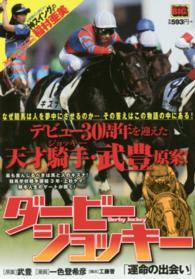- ホーム
- > 洋書
- > 英文書
- > Business / Economics
基本説明
Flood and Garber confess to a "fixation on understanding extreme events" such as speculative bubbles, currency reforms, and speculative attacks on fixed exchange rate regimes and metallic monetary standards - all markers of economic change.
Full Description
Robert Flood and Peter Garber confess to a "fixation on understanding extreme events" such as speculative bubbles, currency reforms, and speculative attacks on fixed exchange rate regimes and metallic monetary standards--all markers of economic change. This book brings together their research in these areas during the 1980s and early 1990s, highlighting in particular the close relation of their work on bubbles to that of policy switching, or understanding the impact of prospective and past policy changes on individual economic behavior. Among the earliest contributors to the policy switching literature, Flood and Garber note that policy switching has become popular because the approach permits economists to come to grips with peculiar behavior that surrounds crises and other discrete events. The approach has also allowed economists to combine their understanding of economic behavior in times of crisis with observations of behavior during more normal times.The papers in the book are grouped into three sections: the first on price bubbles is primarily financial; the second on speculative attacks (on exchange rate regimes) is international in scope; and the third, on policy switching, is concerned with monetary policy.
Contents
Part 1 Speculative bubblesbubbles - the first tests, Robert P. Flood and Peter M. Garber; famous first bubbles, Peter M. Garber; tulipmania, Peter M. Garber; on testing for speculative bubbles, Robert P. Flood and Robert J. Hodrick; an evaluation of recent evidence on stock market bubbles, Robert P. Flood et al; asset price volatility, bubbles, and process switching, Robert P. Flood and Robert J. Hodrick; on the equivalence of solutions in rational expectations Models, Edwin Burmeister et al; multi-country tests for price-level bubbles, Robert P. Flood et al. Part 2 Speculative attacks: collapsing exchange-rate regimes, Robert P. Flood and Peter M. Garber; gold monetization and gold discipline, Robert P. Flood and Peter M. Garber; recurrent devaluation and speculative attacks on the Mexican peso, Herminio Blanco and Peter M. Garber; the Belmont-Morgan Syndicate as an optimal investment banking contract , Peter M. Garber and Vittorio U. Grilli; real aspects of exchange-rate regime choice with collapsing fixed rates, Robert P. Flood and Robert J. Hodrick; exchange-rate regimes in transition - Italy 1974, Robert P. Flood and Nancy P. Marion; the linkage between speculative attack and target zone models of exchange rates - some extended results, Robert P. Flood and Peter M. Garber. Part 3 Policy switching: a model of stochastic process switching, Robert P. Flood and Peter M. Garber; an economic theory of monetary reform, Robert P. Flood and Peter M. Garber; process consistency and monetary reform - some further evidence, Robert P. Flood and Peter M. Garber; nominal contracts in a bimetallic standard, Peter M. Garber; monetary policy strategies, Robert P. Flood and Peter Isard; transition from inflation to price stability, Peter M. Garber; comment on bringing down inflation, Robert P. Flood.








